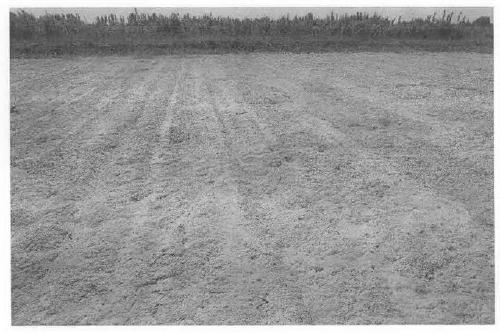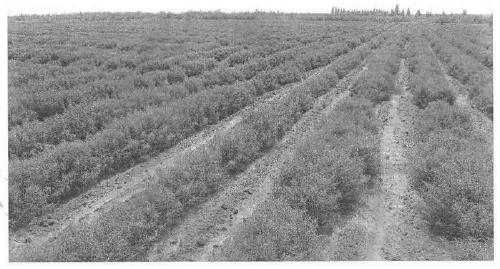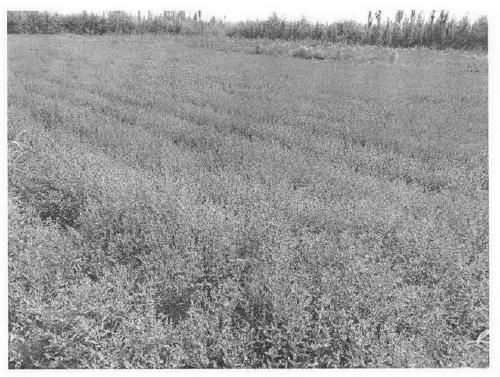A method for planting salt-tolerant forage grass by brackish water irrigation in saline-alkaline sand wasteland
A saline-alkali sand, brackish water technology, applied in the fields of botany equipment and methods, plant cultivation, horticulture, etc., can solve the problems of restricting the sustainable development of agriculture, fragile ecological environment, lack of water resources, etc.
- Summary
- Abstract
- Description
- Claims
- Application Information
AI Technical Summary
Problems solved by technology
Method used
Image
Examples
Embodiment 1
[0024] In 2016, in Karsai Township, Moyu County, Hetian, the test of planting halophytic pasture in brackish and shallow diving in sandy wasteland was carried out:
[0025] Lot selection:
[0026] a. The saline-alkaline sandy wasteland reclaimed in 2013 has tried to plant alfalfa, corn, winter wheat, etc., but it is difficult to emerge, and it is basically in an abandoned state. Water can be diverted for irrigation during the peak flood period;
[0027] Plant selection:
[0028] b. In 2016, 20 mu of Suaeda salsa were planted in a pilot demonstration;
[0029] Land consolidation:
[0030] c. Before sowing, spread 5 tons of livestock manure and straw gasket fertilizer per mu, rotate 20cm, and suppress;
[0031] sowing:
[0032] d. Adopt drip irrigation planting, the planting period is in the first ten days of May, mechanical ditching, spacing 0.8m, ditch depth 10cm, ditch width 30cm, set the drip irrigation belt with large dripper flow at the bottom of the ditch, and put th...
Embodiment 2
[0038] In 2016, a saline pasture planting experiment was carried out in the saline-alkali sandy wasteland of Abati Town, Tajik, Kashgar;
[0039] Lot selection:
[0040] a. The depth of groundwater in the outer edge of the oasis is 1.0-3.0m. The saline-alkaline sand wasteland reclaimed in 2014 is mainly phreatic water with a salinity of 3.0g / L. Jerusalem artichoke and cotton were tried in 2015, and it was difficult to preserve seedlings. no harvest;
[0041] Plant selection:
[0042] b. In 2016, 5 acres of wild elm spinach were promoted and demonstrated;
[0043] Land consolidation:
[0044] c. Before sowing, spread 6 tons of livestock manure and straw gasket fertilizer per mu, rotate 25cm, and suppress;
[0045] sowing:
[0046] d. Adopt drip irrigation planting, the planting period is in the middle of May, mechanical ditching, the ditch spacing is 1.2m, the ditch depth is 13cm, and the ditch width is 40cm. Spinach seeds are sown on both sides of the drip irrigation bel...
Embodiment 3
[0052] In 2016, in Karsai Township, Moyu County, Hetian, the test of planting halophytic pasture in brackish and shallow diving in sandy wasteland was carried out:
[0053] Lot selection:
[0054] a. Choose a flat saline-alkali sand wasteland with a groundwater depth of 1.0-3.0m and a phreatic salinity of 5.0g / L around the oasis;
[0055] Plant selection:
[0056] B, select to plant halophytic herbage plant to be 5 mus of red leaf quinoa;
[0057] Land consolidation:
[0058] c. Before sowing, spread 8 tons of livestock manure and straw gasket fertilizer per mu, rotate 30cm, and suppress;
[0059] sowing:
[0060] d, adopt drip irrigation planting, the planting period is in early May, mechanical ditching, the ditch spacing is 1.0m, the ditch depth is 15cm, and the ditch width is 35cm. The seeds are sown on both sides of the drip irrigation belt in the ditch;
[0061] Irrigation management:
[0062] e. Drip water immediately after sowing. Drip water once every 1-2 days d...
PUM
 Login to View More
Login to View More Abstract
Description
Claims
Application Information
 Login to View More
Login to View More - R&D
- Intellectual Property
- Life Sciences
- Materials
- Tech Scout
- Unparalleled Data Quality
- Higher Quality Content
- 60% Fewer Hallucinations
Browse by: Latest US Patents, China's latest patents, Technical Efficacy Thesaurus, Application Domain, Technology Topic, Popular Technical Reports.
© 2025 PatSnap. All rights reserved.Legal|Privacy policy|Modern Slavery Act Transparency Statement|Sitemap|About US| Contact US: help@patsnap.com



